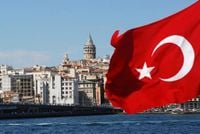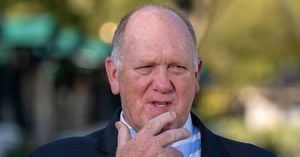In the shadow of Russia’s ongoing invasion of Ukraine, the debate over Europe’s security future has reached a fever pitch. From Tallinn to Helsinki, leaders and security experts are wrestling with the meaning of “deterrence” and the urgent need for credible action, not just rhetoric. The latest developments—ranging from Estonia’s public security alarm to Finland’s diplomatic outreach to India—highlight both the complexity and the stakes of the struggle to contain Russian ambitions and secure a lasting peace for Europe.
Russia’s attachment to its imperial legacy has been a defining feature of its foreign policy well into the 21st century, according to EUobserver. The dissolution of the Soviet Union in 1991, which many in the West saw as the inevitable triumph of democracy, was experienced in Russia as a profound trauma. The collapse destroyed the statehood, or ‘gosudarstvennost’, that had defined Russian identity for over a thousand years. Nowhere was this loss more deeply felt than in Ukraine—a land many Russians see as the cradle of their own state, tracing roots back to the ancient Orthodox polity of Kievan Rus.
The turmoil and instability of the 1990s, coupled with Russia’s diminished geopolitical status, left many Russians longing for the restoration of past greatness. This nostalgia, combined with a sense of encirclement as NATO expanded eastward in the late 1990s and early 2000s, laid the groundwork for the assertive, often aggressive, foreign policy that has characterized Vladimir Putin’s rule. The Kremlin’s refusal to accept a post-Cold War order that relegated Russia to the periphery of Europe has been clear. Instead, Russia has repeatedly asserted itself—most notably with the 2014 annexation of Crimea and the full-scale invasion of Ukraine in 2022.
Putin’s actions, far from being isolated responses to Western provocation, are seen by many analysts as the latest manifestation of a centuries-old imperial tradition. In 2014, Putin revived the Tsarist-era concept of ‘Novorossiya’, claiming vast swathes of modern Ukraine as historically Russian territory. Russia’s 2023 foreign policy concept went further, declaring the country a “unique country-civilisation” that unites the Russian people and others within the so-called “Russian world.” As EUobserver notes, this vision signals long-term expansionist intentions—and a willingness to use force to achieve them.
For NATO and its member states, this presents a systemic security challenge that cannot be ignored or wished away. Estonia, perhaps more than any other European country, has sounded the alarm. On September 22-23, 2025, Estonia’s diplomatic “air raid siren” prompted an emergency meeting of the United Nations Security Council to discuss the country’s security situation, as reported by ERR. The message from Tallinn is clear: Europe must be prepared for the possibility of further Russian aggression, and deterrence must be more than just a buzzword.
Meelis Oidsalu, a prominent Estonian security commentator, has argued that the term “deterrence” is too often invoked without real substance behind it. “If we’re not prepared to say clearly that deterrence means being ready to defend Ukraine and fight Russia there, then we shouldn’t use the term at all,” Oidsalu stated on Vikerraadio. He criticized NATO’s tendency to use the language of deterrence in contexts where military capability is lacking or actions are purely symbolic, such as small-scale exercises or operations with insufficient resources.
Oidsalu’s critique is echoed by others in the Baltic security community, who point out that while NATO has announced new defense plans for the region, forward-deployed forces and essential capabilities—like combat drones and missile defense—are still lacking. Estonia’s own IRIS-T medium-range air defense system, ordered from Germany, is not expected to arrive until 2026, and recent readiness exercises have highlighted the need for further improvements in air defense. “Part of deterrence is inevitably about posture,” Oidsalu notes, “but the issue lies in proportionality and in how the meaning of the word is diluted when that proportionality is skewed in favor of posturing over action.”
Meanwhile, Finland’s President Alexander Stubb has taken the debate to the international stage. Speaking at the Helsinki Security Forum on September 22, 2025, Stubb made headlines by calling for India’s involvement in the Ukraine peace process. “India has a geopolitical stake here. We need to get them involved,” Stubb said, revealing that he has been in contact with Indian Prime Minister Narendra Modi about facilitating dialogue between Moscow and Kyiv. Stubb’s roadmap for peace begins with a ceasefire, followed by a direct meeting between Ukrainian President Volodymyr Zelenskyy and Russian President Vladimir Putin, and culminating in broader negotiations.
Stubb has also emphasized the need for Europe to be clear-eyed about what security guarantees for Ukraine really mean. In an interview with The Guardian, he argued, “Security guarantees for Ukraine must include the willingness of European countries to go to war with Russia if Moscow attacks Ukraine again.” He added, “Deterrence must be credible, and for it to be credible, it must be strong.” His remarks come after discussions with Modi in August 2025, where they also reviewed EU-India trade, and cooperation in emerging technologies like 6G and artificial intelligence.
The debate over deterrence is not just academic. As Oidsalu points out, “Deterrence, like love, is in its truest and most effective form an action, not a buzzword.” Information operations and symbolic gestures have their place, but they cannot substitute for real changes on the ground—be it the deployment of air defense units, the rotation of troops, or the provision of military aid. Estonia has set a notable example, committing to spend 0.25 percent of its GDP annually on military support for Ukraine. Following this lead, other NATO members could demonstrate their resolve not just through words, but through concrete actions that enhance Ukraine’s defensive capabilities.
Yet, as the prospect of a ceasefire or peacekeeping mission in Ukraine is floated, questions remain about the West’s political will. Oidsalu warns that if deterrence messaging is not backed by “specific changes in the defense landscape,” adversaries like Russia will see through the bluff. He urges journalists and policymakers alike to scrutinize official statements and demand clarity on what deterrence actually entails.
Ultimately, the path to peace and stability in Europe hinges on whether Russia is willing to accept the loss of its empire and define its national interests as a post-imperial state. Ukraine’s determined resistance has given the West a rare opportunity to shape the future of European security. But as EUobserver asks, does the West have the political courage and unity to seize it?
The coming months will test not only the credibility of NATO’s deterrence, but also the willingness of Europe and its allies to move from rhetoric to action. As new alliances are forged and old ones tested, the fate of Ukraine—and the security of the continent—hangs in the balance.





